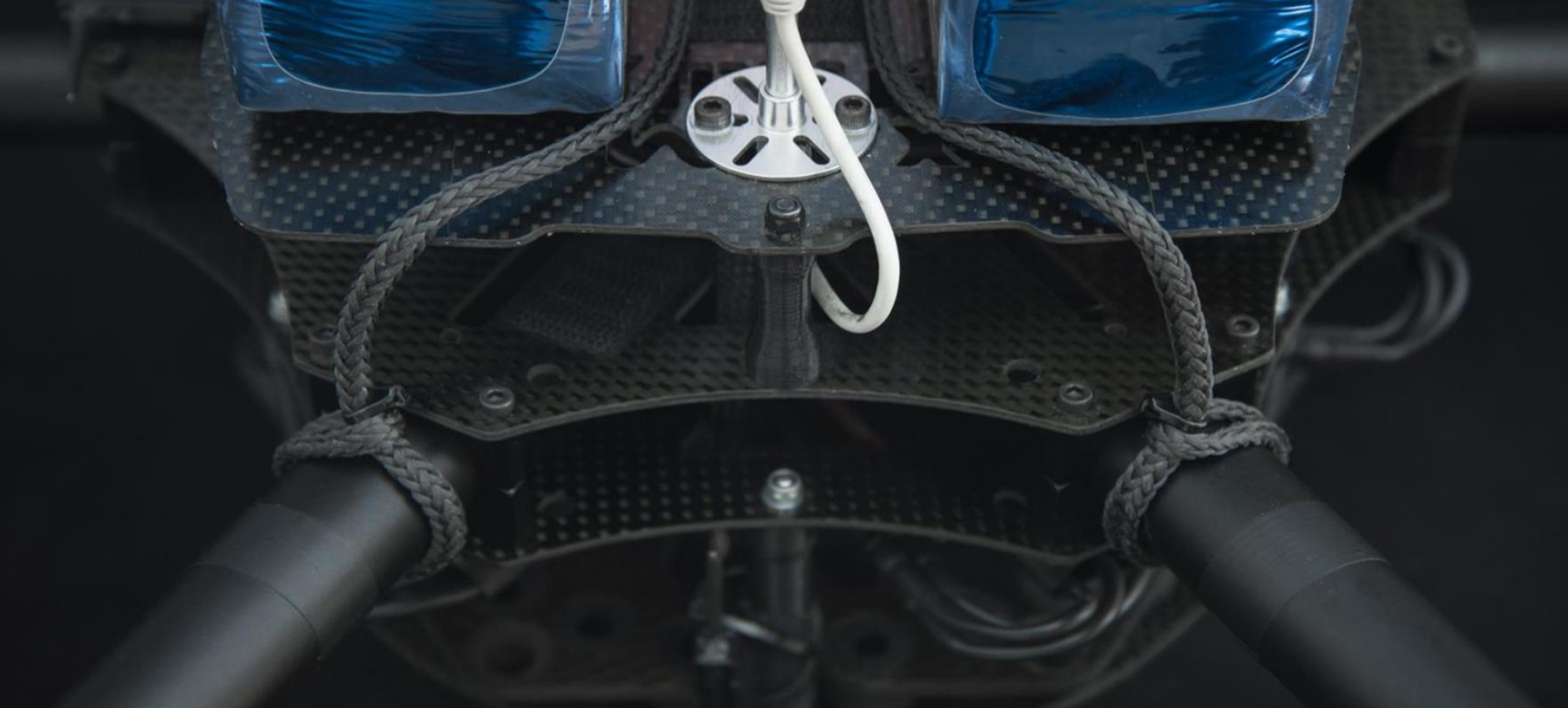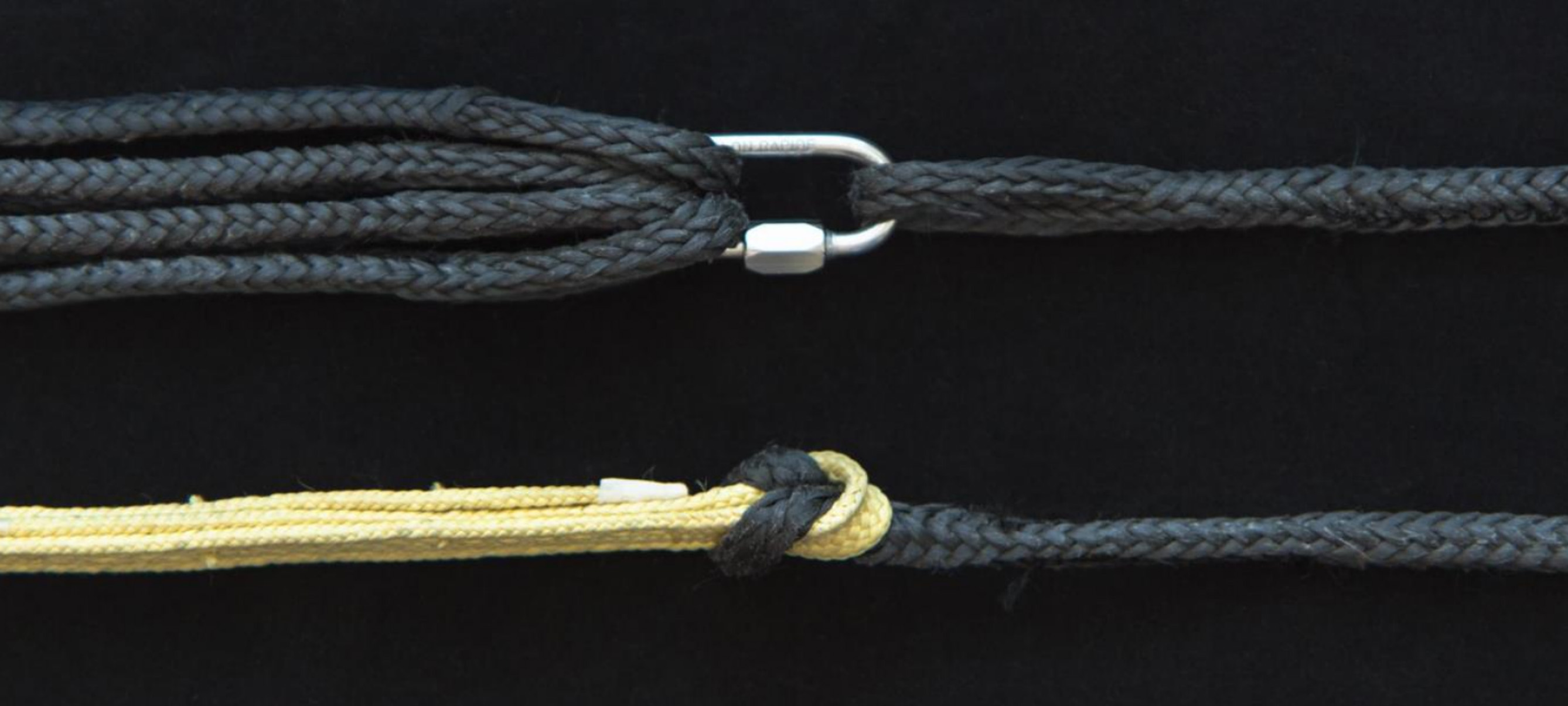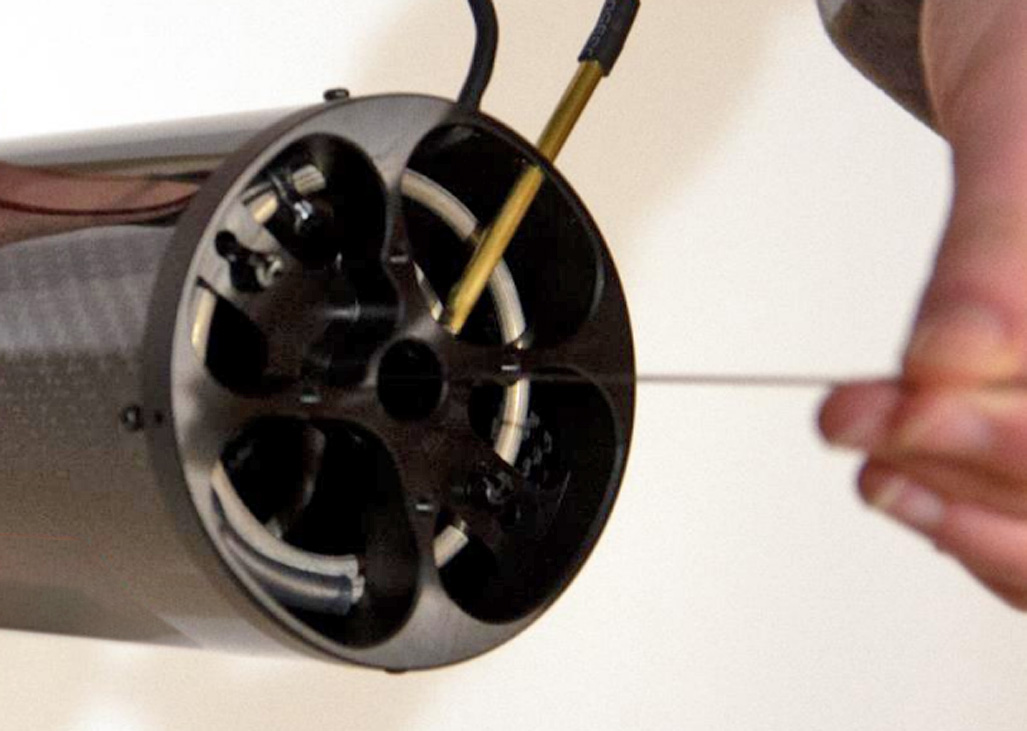¶ Description
Parachute kit for drones and UAVs weighing 8 to 30kg.

¶ Specifications
¶ Features
- Low descent speed
- Separate independent battery
- Easy to install and reload
- No drone warranty infringement
- Full carbon fiber and lightweight CNC milled aluminum construction
¶ Technical
¶ Parachute performance
- Diameter: 305cm
- Descent rate: ~4.6m/s (20kg AUW)
- Impact energy: 206 J (20kg AUW)
- Equivalent freefall from 100cm (20kg AUW)
¶ Electronic unit
- 900gr total weight (parachute + launcher + electronics + battery)
- 3s to 6s operation
- 3x configurable 5v standard RC output channels
- 1x TTL 3.3v serial port for future expansion
| Drone weight, kg | Descent speed, m/s | Impact energy, joules | Freefall equivalent, meters |
| 6 | 2.5 | 19 | 0.32 |
| 8 | 2.9 | 33 | 0.43 |
| 10 | 3.3 | 52 | 0.56 |
| 12 | 3.6 | 75 | 0.66 |
| 14 | 3.8 | 101 | 0.74 |
| 16 | 4.1 | 132 | 0.86 |
| 18 | 4.3 | 167 | 0.94 |
| 20 | 4.6 | 206 | 1.08 |
| 22 | 4.8 | 249 | 1.17 |
| 24 | 5 | 297 | 1.27 |
| 26 | 5.2 | 348 | 1.38 |
| 28 | 5.4 | 630 | 1.49 |
| 30 | 5.6 | 463 | 1.6 |
| No parachute, comparison: | |||
| 10 | 50 | 12500 | ∞ (infinity) |
¶ First installation
The following operations needs to be performed only once, when initially installing the parachute kit to the aircraft, or when transferring the system to another aircraft.
¶ Installing the launcher frame
The launcher is designed to be installed on an arm of the drone with the supplied frame kit.
 |
 |
¶ Securing the parachute to the UAV
When parachute deploys, the entire weight of the drone is supported by the parachute strings, but the G-force in action at the moment of freefall could multiply the momentaneous load that the strings have to bear.
Hence we recommend securing the parachute to 3 or 4 different points of the airframe, possibly evenly distributed around.
Four harness lines are included, so you can efficiently attach them to the most robust points of the airframe.
Only use the provided steel quick-lock; other locks (like keychains, etc) must not be used.
 |
 |
 |
An optional extension cord can be used, to extend the distance between the parachute and the drone.
This stabilizes the descent, and further avoids possibility of wire tangling with propellers.
Use the extension cord between the harness lines and the parachute lines.

¶ Preparing for a flight
¶ Fuses
Systems comes with fuses pre-made.
IMPORTANT: Do NOT use any other fuses or steel wire apart from the ones provided by KopterMax!
This wire is strictly respondant to strength and electrical resistance requirements that are very narrow.
¶ Pre-loading the launcher
Loading the launcher is a very delicate and dangerous operation; a big and powerful spring is used to eject the parachute, so a lot of energy is tored in the system when it is armed.
- Use of safety goggles is recommended while arming the launcher
- Only use the included plunger to compress the spring; any other item can damage the piston inside the launcher

|

|

|

|

|

|
¶ Parachute folding
It is very important that the parachute itself is folded correctly in order to properly deploy.
- Always fold on a clean and dry surface.
- If launcher stays loaded for over two months, this can decrease deployment throw distance in an emergency
It is very recommended to refold the parachute periodically.
- Follow the steps in the video below to perform a correct and safe folding of the chute fabric:
VIDEO - Parachute folding tutorial
- Wrap parachute cloth around the parachute so that black side faces out.
- Insert the folded and wrapped parachute into the launcher tube, paying attention that the rope attaching to the drone is not impeeding the deployment

Make sure ropes do not interfere with propellers!
Do not swing loaded launcher around. G-forces can slide the parachute out accidentally!
¶ System setup
Connect the battery to the electronic unit.
Always connect both cell balancing connector and main power connector from the battery!

¶ Pre-flight checks
Before taking off for a flight, ensure the following checklist is completed in order to avoid misfiring, failures or unattended activations.
- Inspect all components for damages or loose screws/parts
- Before connecting the trigger, check that system is not armed (if using the KopterMax parachute radio, status on display must be “CHECK FUSE”, not "KILL" or "ARMED")
- Ensure trigger is connected and detected by the launcher controller unit (display indication must be “FLY”)
- Make sure the parachute cord is secured to the harness and to the aircraft properly
¶ Operating the system
We recommend launching the parachute a few times as an exercise, before using it in-flight.
- Do not launch on grass, sand, or other loose material. Airflow generated by the piston can suck debris into the launcher.
- Do not touch the fuse immediately after launch, it can remain hot for a while.
¶ Best practice
¶ Things to do
WIP
¶ Things not to do
WIP
¶
Maintenance
¶ Every flight
- Check that the fuse is correctly installed
- Make sure the launcher power cable is connected to the electronics box
- Test propeller clearance by turning them by hand and ensuring they not interfere with parts or wires
- Check that battery is not bulging or swollen
¶ After deployment
- Carefully inspect all the mechanical components for damages due to crash landing or launcher activation.
The spring in the parachute launcher is so powerful that it may occasionally damage the launcher or mounting hardware. - Remember to remove the blown fuse from the launcher tube. Pay attention that now the fuse is split in half and there will be two pieces of steel wire to remove, one at the bottom and one at the top of the tube.
- Check the parachute for tears, holes or broken ropes.
- Check that the ropes securing to the aircraft frame are still solid, and that no damages have been caused to the drone frame.
¶ Every 20 flights
- Check that the cells in the battery are still well balanced (voltage difference under 0.2v at any state of charge)
- Remove and repack the parachute to avoid permanent damage to the fabric
¶ Replacement parts
You can purchase spare fuses, batteries and chargers by contacting KopterMax directly, or one of our worldwide distributors.
¶ Fuses
Due to the delicate nature of the component, use of KopterMax-provided fuses is mandatory.
We cannot guarantee safe operation of the device with any other fuse.
¶ Batteries
If for some reason you can't use original KopterMax batteries to power the parachute kit, you can use any standard 3-6s battery that can give 60 A peak for 10 seconds or more.
We do NOT recommend tampering with high power batteries if you are not fully confident.
Severe risk of violent fire and explosion exists if any battery wire shorts out!